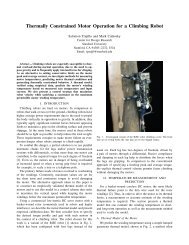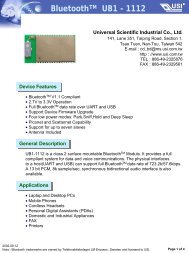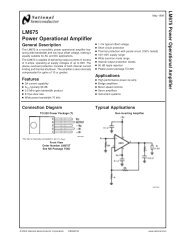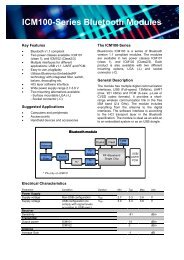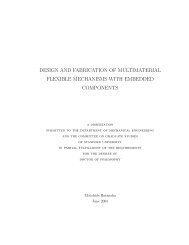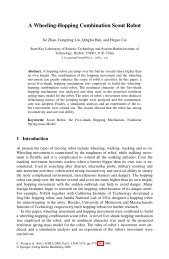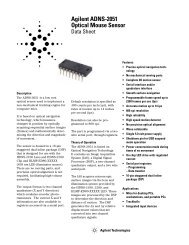A new type of tactile sensor detecting contact force and hardness of an
A new type of tactile sensor detecting contact force and hardness of an
A new type of tactile sensor detecting contact force and hardness of an
You also want an ePaper? Increase the reach of your titles
YUMPU automatically turns print PDFs into web optimized ePapers that Google loves.
We conclude that in order to detect a ch<strong>an</strong>ge in the <strong>hardness</strong><br />
<strong>of</strong> the touched object, the elastic const<strong>an</strong>t <strong>of</strong> the diaphragm<br />
should be almost the same as that <strong>of</strong> the touched object.<br />
Based on this result, we obtained equation (4), which lets<br />
us determine the diaphragm size. From equations (2) <strong><strong>an</strong>d</strong><br />
(3), <strong><strong>an</strong>d</strong> the choice <strong>of</strong> Kd=K,, the relationship between the<br />
radius <strong><strong>an</strong>d</strong> thickness <strong>of</strong> the diaphragm is given by equation<br />
(4).<br />
The procedure for determining the diaphragm specifications<br />
is as follows.<br />
(1) First, we determined from <strong>an</strong>other experiment that K,s<br />
<strong>of</strong> a fingertip is 330a (kN/m).<br />
(2) Using KS=330a (kN/m), we plotted the relationship<br />
between diaphragm radius <strong><strong>an</strong>d</strong> thickness (equation (4))<br />
to determine the size <strong>of</strong> a <strong>sensor</strong> device that c<strong>an</strong> detect<br />
the <strong>hardness</strong> <strong>of</strong> a fingertip (Fig. 5).<br />
(3) We determined that its minimum thickness is 6.0 pm<br />
because <strong>of</strong> the diffusion depth <strong>of</strong> the piezo-resist<strong>an</strong>ce<br />
layer formed on the diaphragm.<br />
(4) Finally, we chose the diaphragm radius as 1 .O mm, <strong><strong>an</strong>d</strong><br />
designed three different <strong>type</strong>s <strong>of</strong> <strong>sensor</strong>s, which are<br />
shown in Fig. 5.<br />
(a) An n-<strong>type</strong> 4" silicon wafer with resistivity <strong>of</strong>20.4 ficm<br />
was used for fabricating the <strong>sensor</strong>. First, we formed a<br />
silicon oxide layer 500 nm thick on the surface by<br />
thermal oxidization. We patterned it to define the area<br />
<strong>of</strong> the piezo-resist<strong>an</strong>ce sensing elements. Then, we<br />
diffused boron into the opened area <strong>of</strong> the silicon oxide<br />
layer to form p-<strong>type</strong> silicon. The diffused area works as<br />
the displacement <strong>sensor</strong> <strong>of</strong> the diaphragm.<br />
(b) The surface was covered with <strong>an</strong> oxide layer 800 nm<br />
thick, Then a silicon nitride layer was deposited on only<br />
the rear side <strong>of</strong> the wafer. This keeps the rear wafer<br />
surface flat during the following process.<br />
(c) Contact holes were patterned on the front side surface.<br />
Then, for the electrical wiring, <strong>an</strong> AI layer 1 .O pm thick<br />
was deposited by sputtering <strong><strong>an</strong>d</strong> patterned by wet<br />
etching. Finally the surface was covered with a silicon<br />
nitride layer 300 nm thick for protection against the<br />
environment.<br />
(d) The bonding pads for the electrical wiring were patterned<br />
on the front side <strong>of</strong> the wafer, <strong><strong>an</strong>d</strong> the rear side layers<br />
(silicon oxide <strong><strong>an</strong>d</strong> silicon nitride) were patterned to<br />
define the aperture <strong>of</strong> the diaphragm.<br />
Points o! designed devices<br />
Table 1 shows the typical specifications <strong>of</strong> the <strong>sensor</strong><br />
designed for <strong>detecting</strong> the touch <strong>of</strong> a fingertip.<br />
FABRICATION PROCESS<br />
We developed a fabrication process for the <strong>sensor</strong> element<br />
<strong>of</strong>the proposed <strong>tactile</strong> device system to confirm the principle<br />
(Fig. 6). The process is summarized as follows.<br />
"0 0.5 I .o I .5<br />
Radius <strong>of</strong> diaphragm: r (mm)<br />
Fig. 5. Relationship between the rudius und the thickness<br />
<strong>of</strong> diuphrugm suitable for <strong>detecting</strong> hurdnexs ($u hum<strong>an</strong><br />
finger tip (K.s=Kd Ks=330u (kN/m)).<br />
Table I. SpeciJicutions ($<strong>sensor</strong> device.<br />
Elastic const<strong>an</strong>t Ks <strong>of</strong> object<br />
Fig. 4. Relutionship between the defiwmution und elustic<br />
constunt <strong>of</strong>the object. K,y: elustic constunt <strong>of</strong>the object,<br />
Kd. elustic constunt <strong>of</strong>the diuphrugm.<br />
Device<br />
3.0 mm x 3.0 mm x 0.425 mm<br />
Diaphragm 1.0 mm x 1.0 mm x 6.0 pm<br />
Mesa (SU-8) 0.1 mmxO.lmmx30pm<br />
Piezo-resist<strong>an</strong>ce<br />
displacement <strong>sensor</strong><br />
0.10 mm x 0.16 mm<br />
(Resit<strong>an</strong>ce 920 Q)<br />
Elastic const Kd 960 - 1400 N/m<br />
346




